Regista, an Italian word that translates to “director” in English, is a term tied to former greats like Andrea Pirlo at Juventus and Real Madrid’s maestro, Xabi Alonso. At its core, regista are deep-lying playmakers with limited defensive responsibilities. From that deep role, they structure the teams attack, set the tempo and use their passing range to break the opposition’s press.
Though players like Pirlo and Alonso have moved on to management, the role is still used by many possession dominant teams around the world. The most famous example is the heir to the regista throne, Real Madrid’s Toni Kroos.
Much like Pirlo, Kroos was a more advanced midfielder in his younger years, playing as a #10. However, as I discussed at some length in my book, Revitalizing Real Madrid, Zinedine Zidane has dropped Kroos deeper into the midfield in an effort to better the team’s rest defence. From that deeper role, Zidane has transformed the German into the team’s tempo setter.
In this scout report, we’ll take a look at Kroos’s role within Zidane’s tactics. Our tactical analysis starts with Kroos’ more common regista responsibilities, particularly as a deep-lying playmaker. Once that portion of the analysis is complete, I’ll show how he sets the tempo from that deeper role as well as how his defensive responsibilities are tailored to his attacking contribution.
Deep-lying playmaker
Like the registas before him, Kroos does his damage from the deeper regions of the pitch. It’s common to see the German move into the deep end of the left half space. From there, he’s on his preferred right foot with an open body orientation that allows him to play to any part of the pitch. In addition to moving wide, Kroos will also drop nearly in line with the centre-backs. The objective is to position himself outside of the opposition’s press, creating more time in space to scan the field and deliver his pass.
Our first image has Real Madrid engaged against Eibar’s middle block. In each of the images, Kroos is marked out with a circle beneath him. Here you can see he is offset to the left, joining Sergio Ramos and Raphaël Varane in a virtual back three. A recent trend in their tactics has Kroos drop into the left half space while Ferland Mendy inverts near the central channel. You can see him on the right side of the field, just outside of the centre circle, leaving Rodrygo to offer width in the formation.
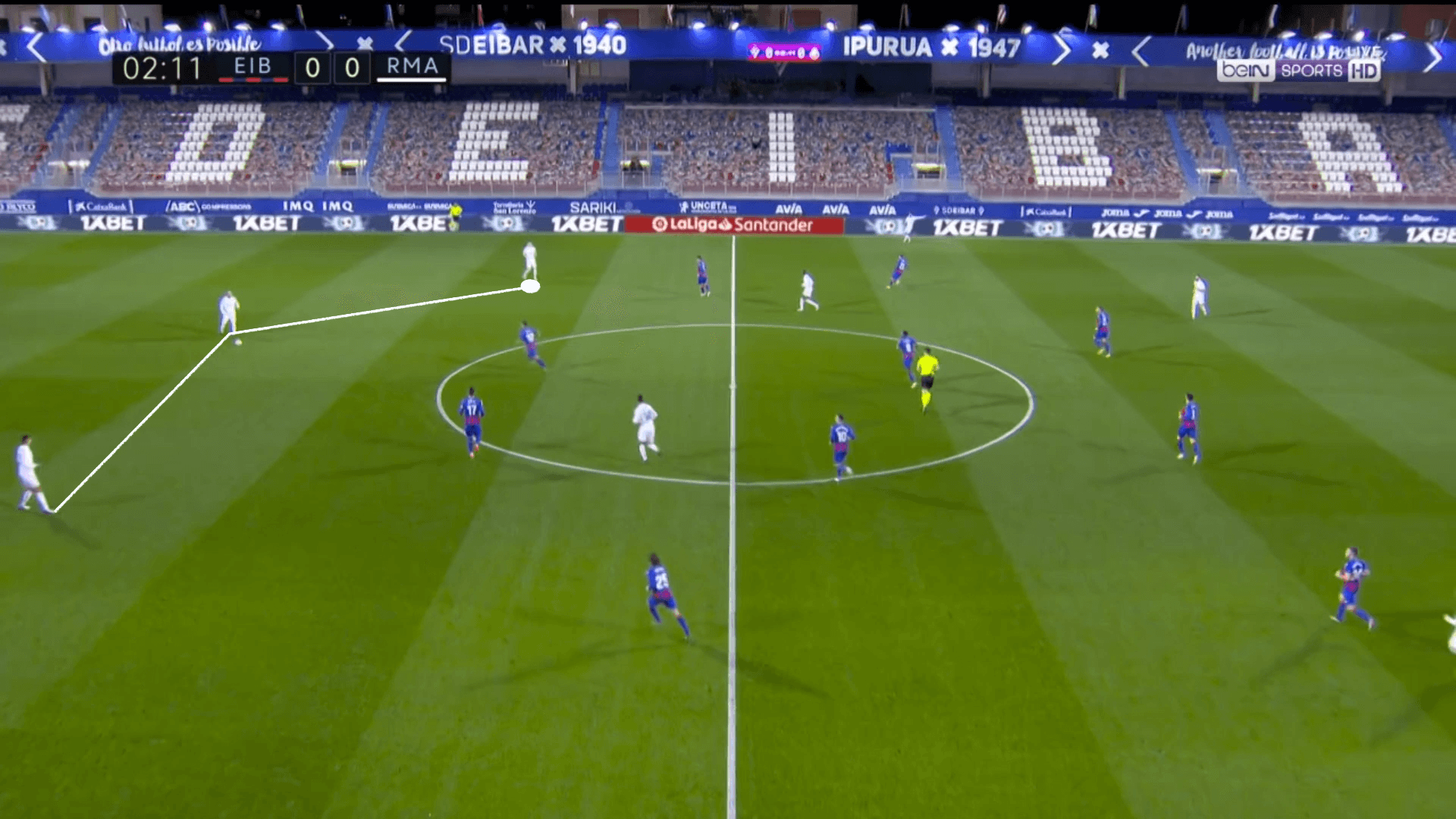
The technical qualities of a regista are of the utmost importance. As a deep-lying playmaker, he’s often the central figure in the build-out. Real Madrid is fortunate enough to have turn highly capable centre-backs within their ranks, easing the pressure on Kroos. Between those three and Casemiro, possibly even Luka Modrić as he swaps roles with the Brazilian, this side is difficult to press high up the pitch.
Even still, Real Madrid enjoy funnelling play to the left-hand side so that Kroos and Ramos can lead the attack. One of the benefits is that both players are press resistant, allowing them to absorb the opponent’s press well safely circulating the ball in tight spaces.
Another advantage is that when Kroos and Ramos circulate the ball on the left-hand side of the pitch, the defence collapses around them. Once the opponent has over-committed, becoming unbalanced in their press, Kroos and Ramos have the ability to play the long diagonal to break pressure. In fact, as they’re circulating the ball short, both players are actively scanning the pitch, looking for high targets that can help the team break pressure.
Since the two players are so similar in their distribution qualities, you might even see Ramos split out to the left while Kroos takes his place centrally.
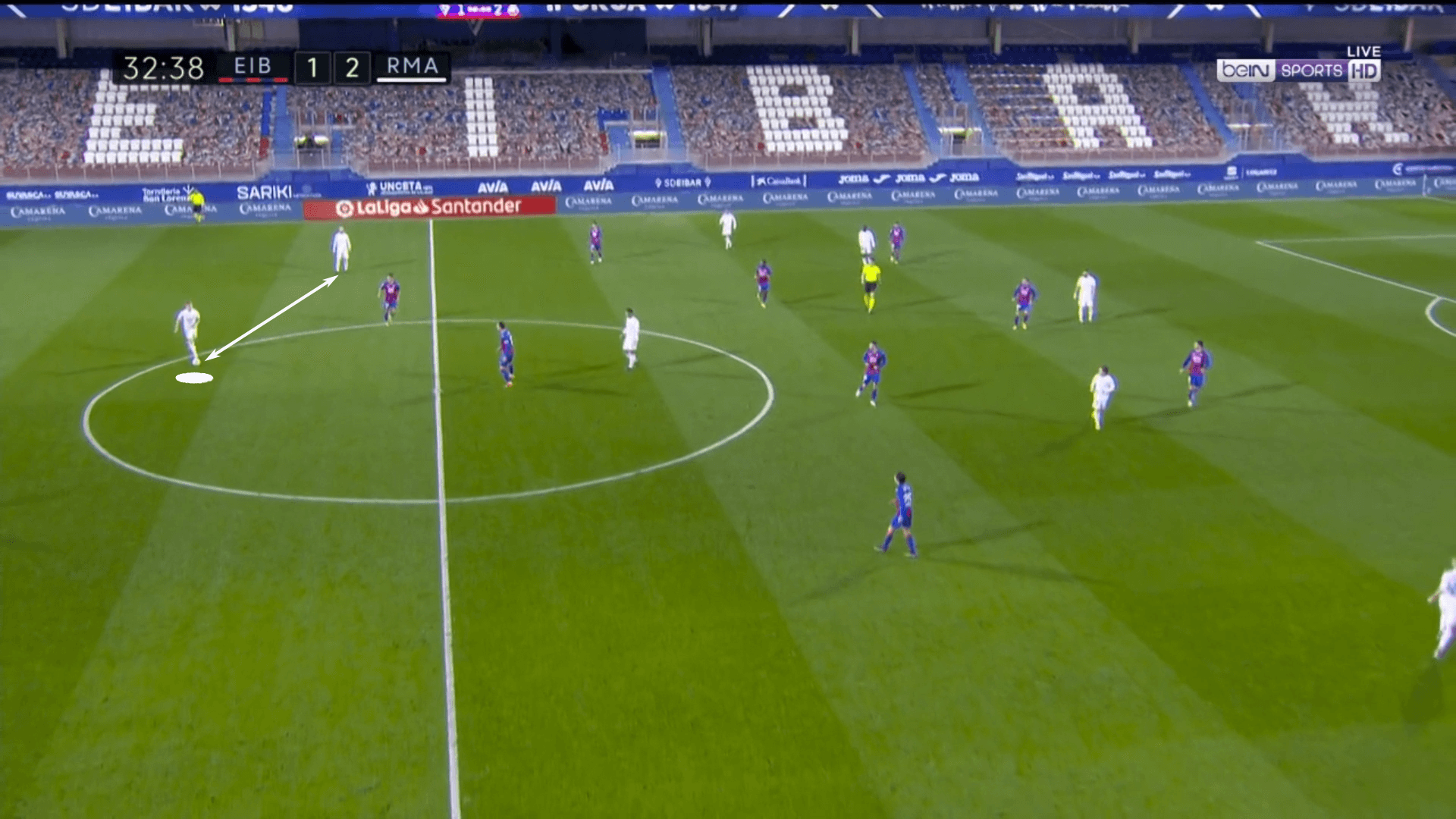
This is especially helpful if Kroos is experiencing extra pressure in the build-up. If opponents commit a player to mark him, or at least keep someone near enough to quickly pressure Kroos when he receives a pass, the German will look for another patch of space outside of the press. Central movement with Ramos splitting out wide can create enough of an advantage to break the opposition’s pressing structure.
Even though Kroos can swap starting points with Ramos, he’s clearly most comfortable in the left half space. in The 36th minute of the match against Eibar, Kroos settled into one of his hotspots outside of the opposition’s press. With time and space to analyse gaps in the opposition’s press and identify runners, Kroos played a brilliant ball over the top, right into the path of Benzema. Had the Frenchman managed to stay onside he would have put Real Madrid up 3-1 before half time.
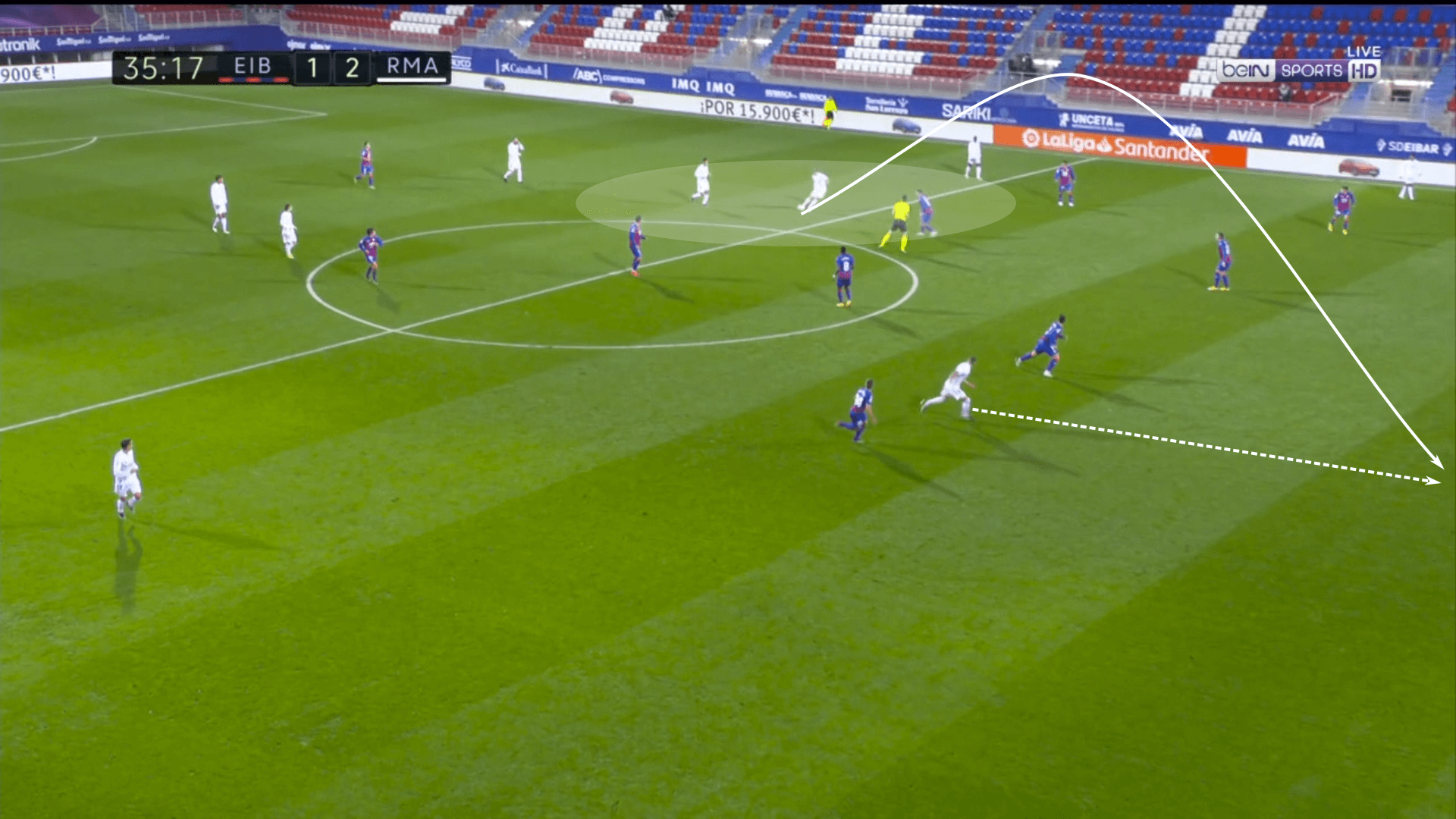
Kroos’ player profile offers a nice understanding of how he occupies the pitch. His heat map shows his two hotspots in the left half space, one on either side of midfield. You’ll find him in the deeper of the two as Real Madrid encounters the middle block. As they progress into the attacking half of the pitch, the concept remains the same. Even as Real Madrid push their opponents into a low block, you still see Kroos positioned outside of the opposition’s press, looking to find pockets of space that will enable him to receive and set up a dangerous pass forward.
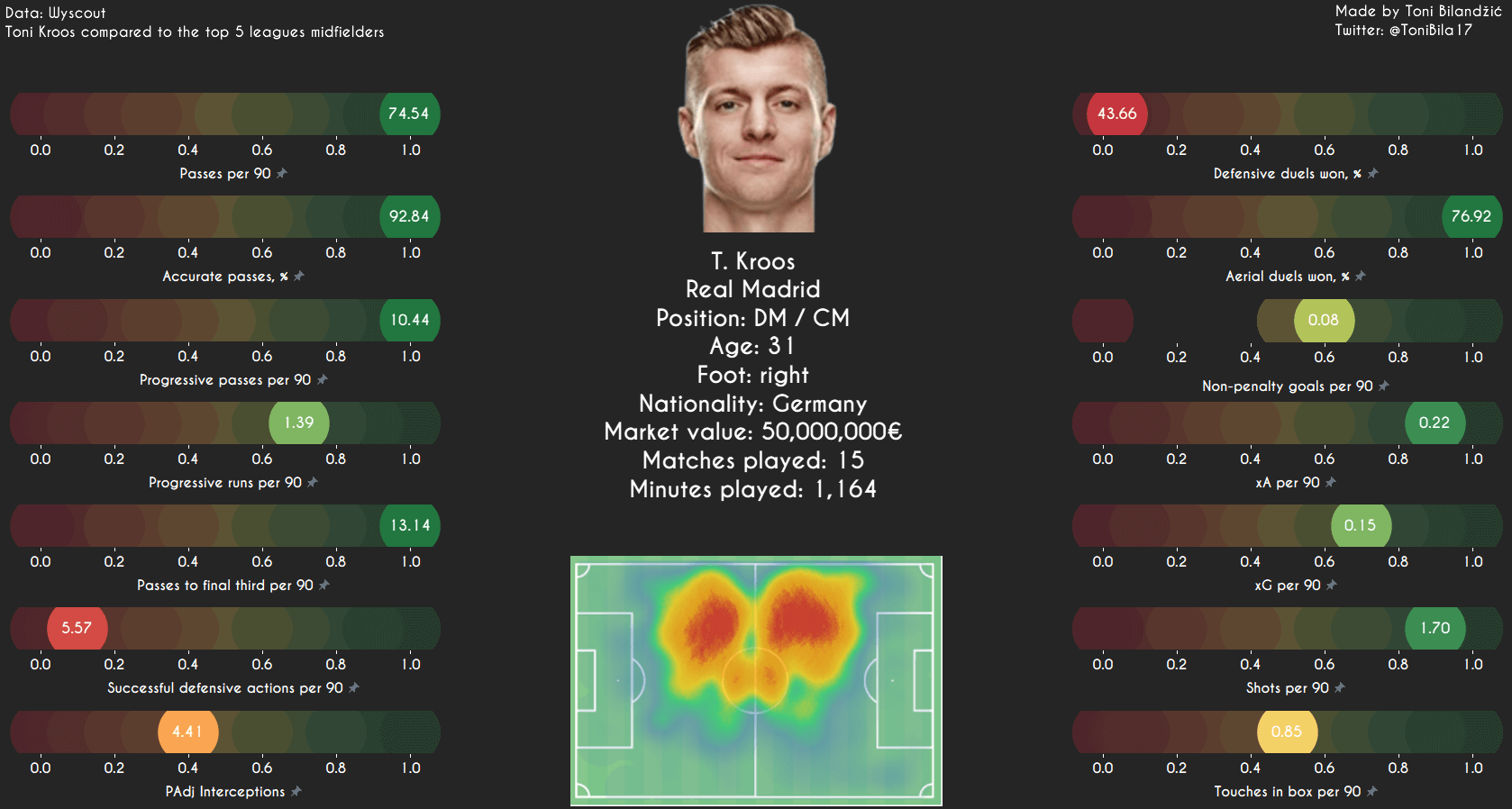
From a statistical standpoint, Kroos rates as one of the best in nearly every passing category among La Liga midfielders. He’s both highly involved and has the pinpoint accuracy that makes him so valuable.
His defensive numbers are rather poor, but, again, registas are not expected to shoulder much of the defensive load. Deep-lying, creative playmaking abilities are what make him so valuable.
When Real Madrid is playing well, Kroos’ ability to stretch the pitch is among the reasons for their success. He rarely puts in a bad touch when his opponents engage in a high press or middle block, so it’s really his ability to break the opponent’s defensive structure with this intermediate to long-range distributions that makes him so important to Real Madrid’s tactics.
Madrid has dropped a number of points this season so, it begs the question, is there a distinction between Krooss performances in wins versus matches where they’ve dropped points?
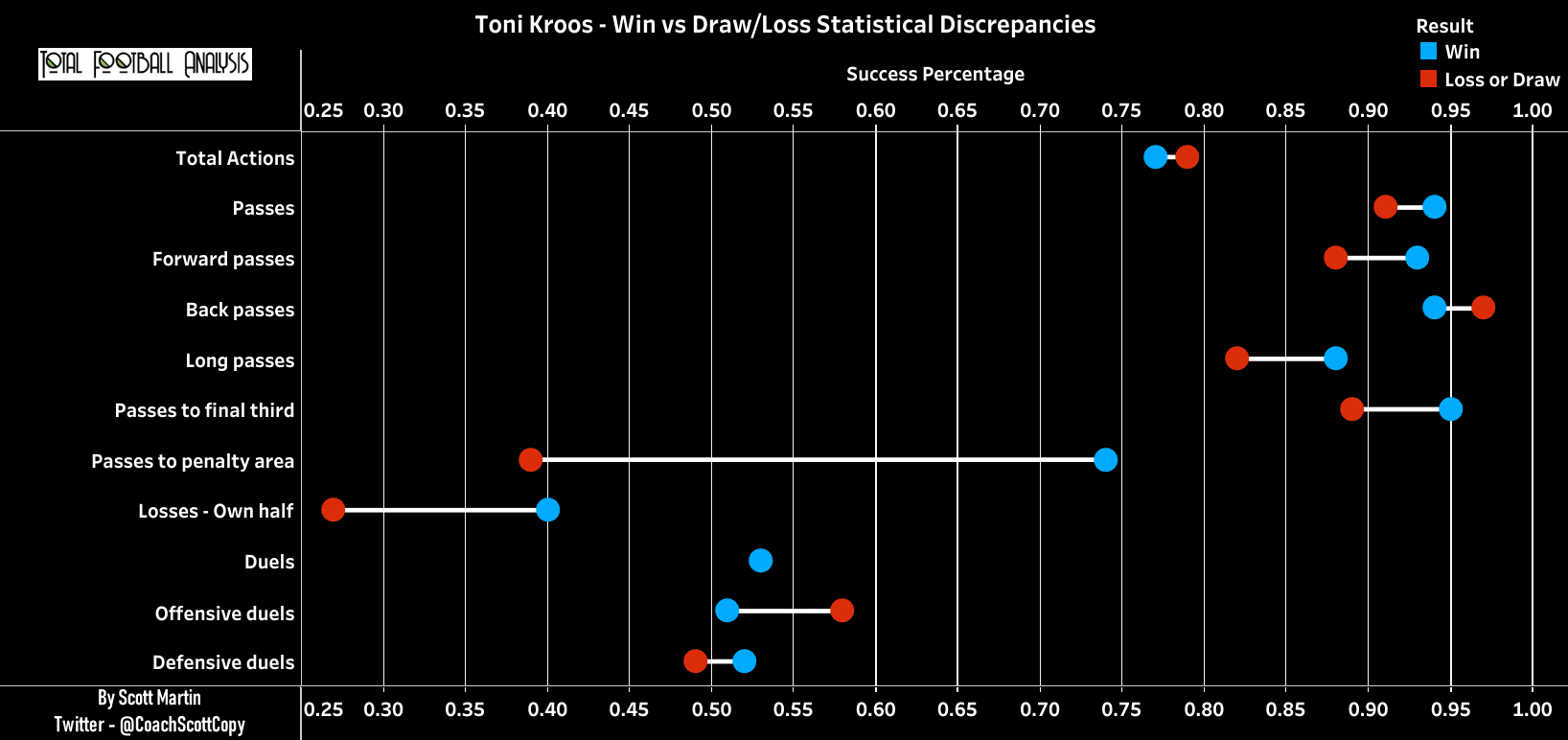
Crunching the numbers produces some interesting conclusions. This barbell chart represents Real Madrid wins with a blue circle and matches with dropped points in red. Each of the categories addresses his success percentages. We want to see if there’s a drop in efficiency between a 3-point performance and a loss/draw.
Interestingly, in losses and draws, Kroos saw a small improvement in the success of his total actions and back passes per 90 minutes. He also saw a reasonable improvement in his offensive duels.
Other than those three categories, decreases in efficiency from a win to matches with dropped points range from minimal to significant. Kroos really can’t improve his passing efficiency much, at least not in regards to passes and forward passes, but it’s interesting to see that is long passes and passes to the final third are at least 6% more efficient in wins.
Then you have his passes to the penalty area and losses in his own half. In losses and draws, Kroos completes 39% of his passes to the penalty area, but in wins, his accuracy improves to 74%. To some degree, this is explained by the more dire situations experienced when either losing or drawing late in the game. At some point, you have to take a chance and try for lower percentage passes.
If there’s any hope for Real Madrid’s opponents, it’s that putting a little bit of extra pressure on Kroos is strongly correlated to negative results for Los Blancos. In a recent 0-0 draw against Osasuna, Kroos was rarely given time to play his trademark long diagonals. Though the game ended 0-0, Madrid had two goals taken back due to offsides, Kroos providing the would-be assists on both plays. When he was able to get longer range passes off, they were dangerous.
Finally, much like Pirlo, Kroos is responsible for Real Madrid set pieces. His distributions have been on point this season with two goals on or immediately following set pieces against Atletico Madrid among the highlights. Whether from a deep position in the flow of play or from set pieces, Kroos has shown a golden touch that makes him the world’s top regista.
Setting the tempo
One of the advantages of playing outside of the opposition’s press is that a regista has time to pick up his head, scan the pitch and dictate the tempo. What’s meant here is that, as the deep-lying playmaker, Kroos is the one who determines how quickly or slowly Real Madrid are going to play. Casemiro has stated on numerous occasions that Kroos pulls the strings. If the team wants to pick up the pace, it’s Kroos who signals the transition in tempo. If there is a need to slow it down, either because the game is becoming too chaotic or there’s a lack of control in possession, the German puts his foot on the ball so his teammates can catch their breath, regained their composure and move into better starting positions.
If the game calls for a slower tempo, you’ll often see Kroos receive the ball and either swing it across the backline or play into teammates in his immediate vicinity who have no other option than to play back into Kroos. If a teammate has pressure on his back and it’s dangerous to turn, Kroos can use that pressure to force him to play the way he faces, which is right back into the feet of the German.
The image taken from the 13th minute against Eibar shows the transition from a low to a high tempo attack. With time in space on the ball, Kroos identifies the runs of Karim Benzema and Dani Carvajal. With the two players making their runs into the central channel, Kroos knows that a long diagonal into their path is a low percentage pass, so he instead plays to Lucas Vázquez, who’s alone in the right-wing.
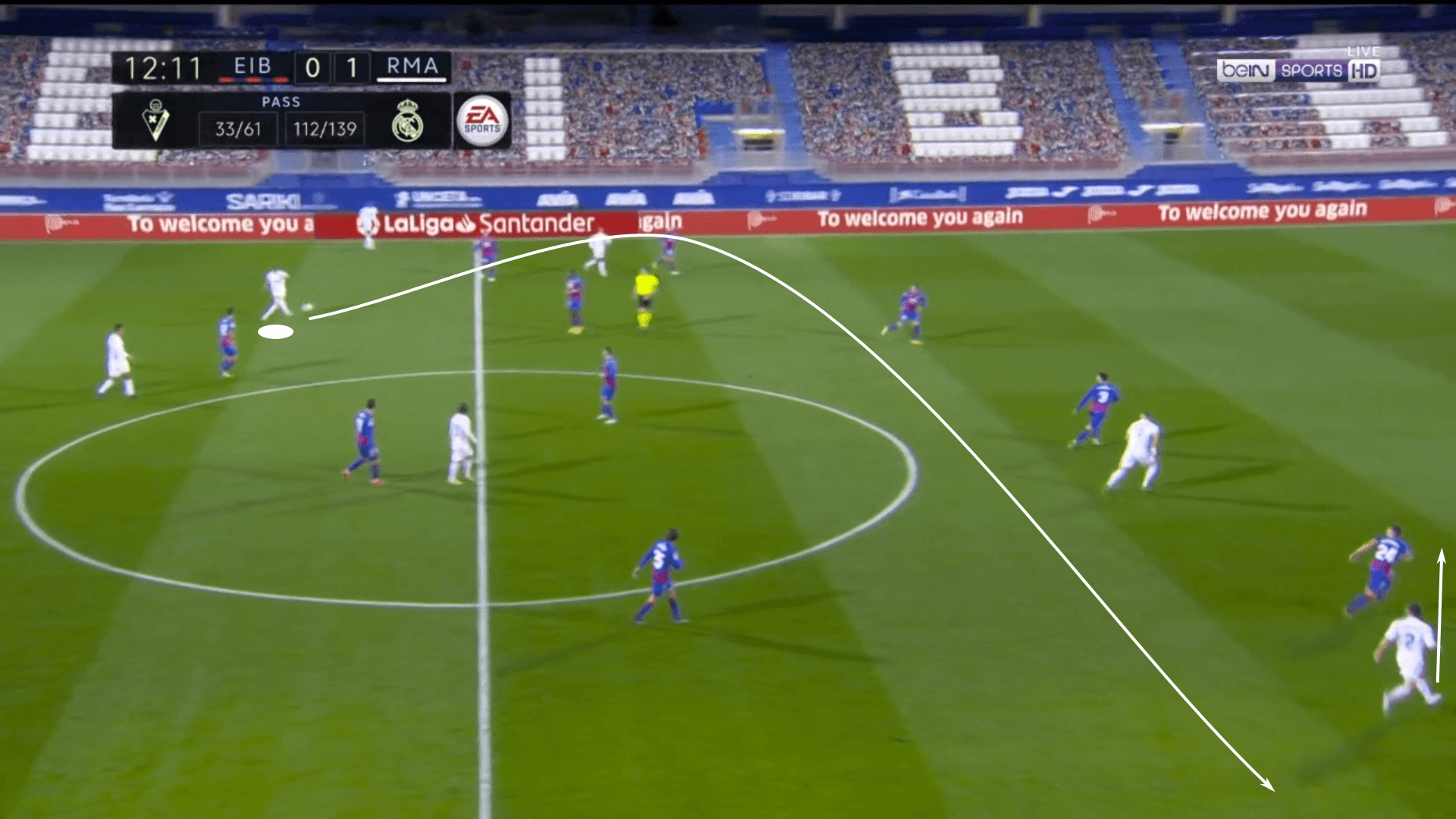
Once Vázquez received the ball, Real Madrid quickly progressed up the right-wing and into the box. A nice combination play produced a Modrić goal, giving Real Madrid 2-0 lead.
But without Kroos’ long diagonal pass, this goal is not happening. With Eibar in a vertically compact 4-4-2 middle block, Kroos’s ability to play over the press freed Vázquez to make his move up the right-wing with Carvajal for a 2v1 high the pitch. Ultimately, Kroos’ distribution produced a numerical superiority for his side, a scenario Eibar was not equipped to handle.
Though his distributions will typically come from the left half space, you will recall that Kroos does occasionally move into the central channel. While the centre is typically occupied by Ramos, when Kroos is there, you’ll often see him use his long diagonals to play to one of the two wings. Against Osasuna, Mendy had acres of space in the left-wing. From there, it was a simple switch of play for Kroos.
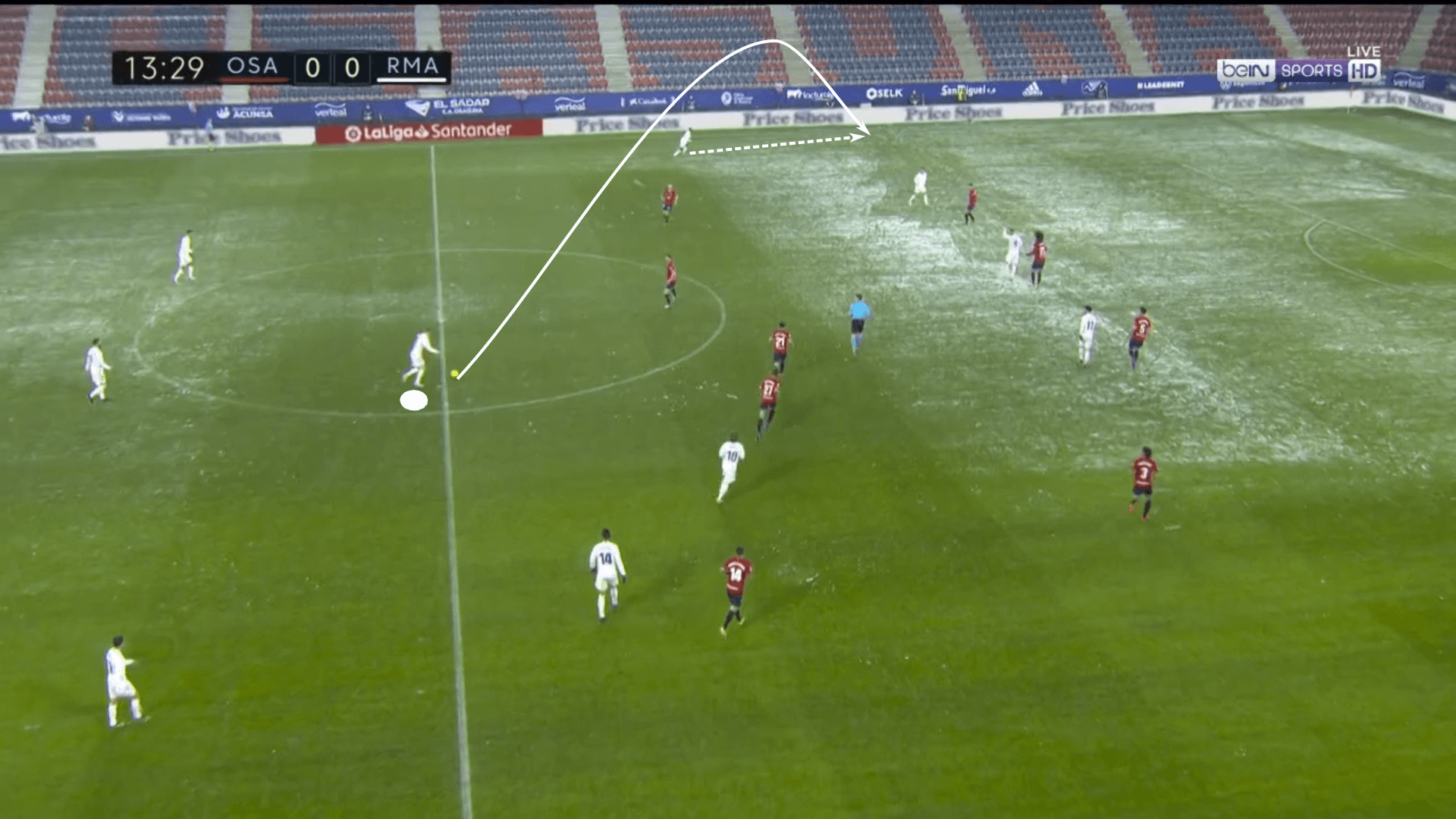
Don’t get the impression that this has been an easy season for Kroos. Madrid do face a significant number of teams who have played with two forwards who prefer more direct, counterattacking styles while keeping numbers behind the ball defensively. When opponents elect to play with two forwards, those half spaces can become a little more compact, dislocating Kroos or, at the very least, putting him in a position where he has too little time and space to execute the long diagonals.
Early in the season, we saw these issues come to light against Inter Milan. The Serie A side used Lautaro Martínez to limit the space available to Kroos. The Argentine had a busy match, chasing down both Ramos and Kroos to limit their ability to play forward.
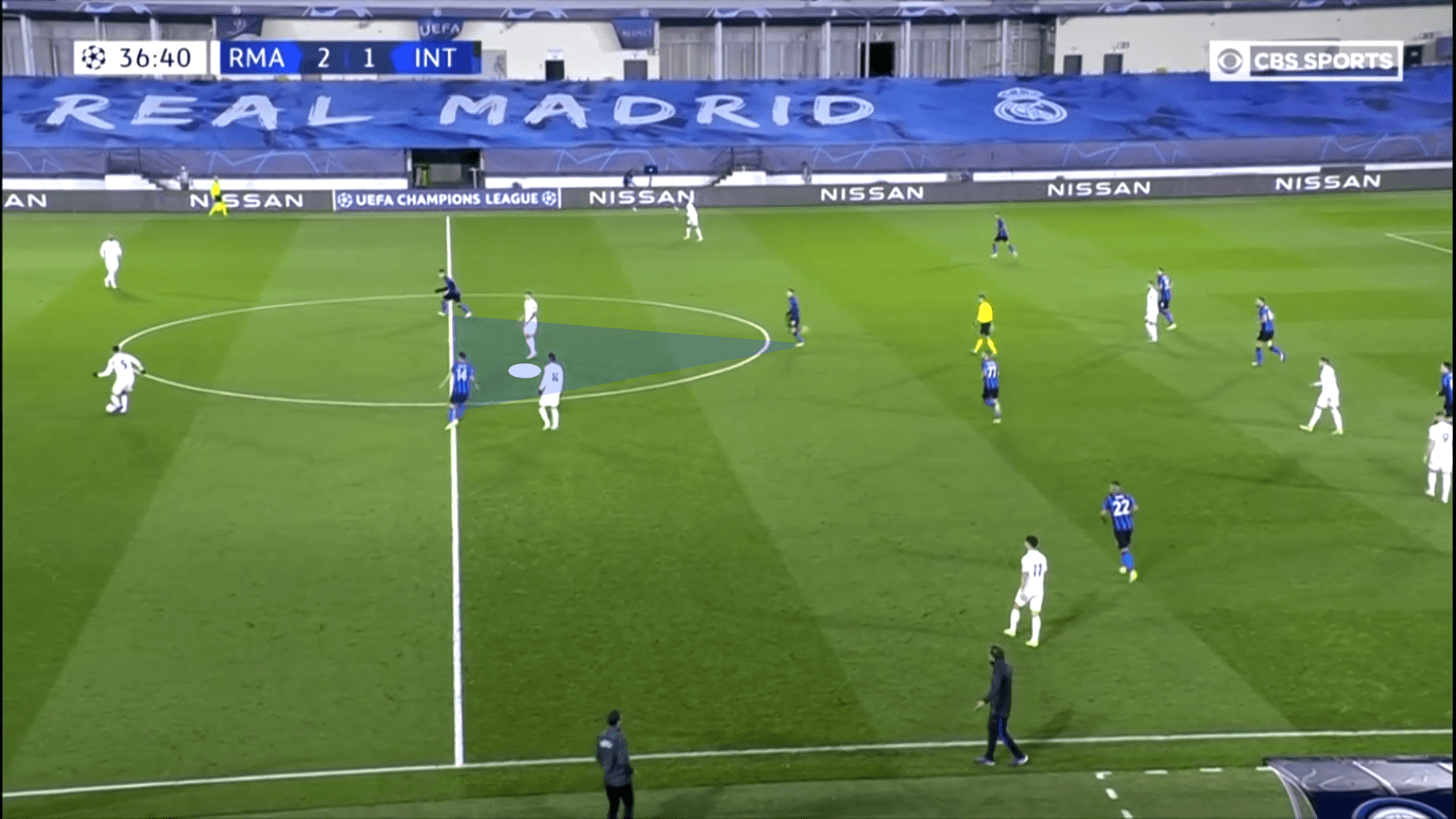
For the most part, it worked. Without room in the left half space, Kroos would occasionally drift into the central channel, but Inter’s three central midfielders were quick to deny entry. Again, target Kroos and the Real attack becomes much less fluid and dangerous.
Engaging in a middle block, much like Inter did, seems like the best way to negate Kroos. As teams slide into a low block, there are simply too many threats to account for, preventing opponents from giving Kroos the required attention. As Real Madrid enter the final third, they’ll often set up in a 2-3-5 or 2-2-6 before starting the move towards goal.
Kroos is a vital part of that shape. As we find against Osasuna, he’s positioned just outside of the opposition’s low block, both allowing him to pick out advanced targets and taking up an important role in Madrid’s rest defence.
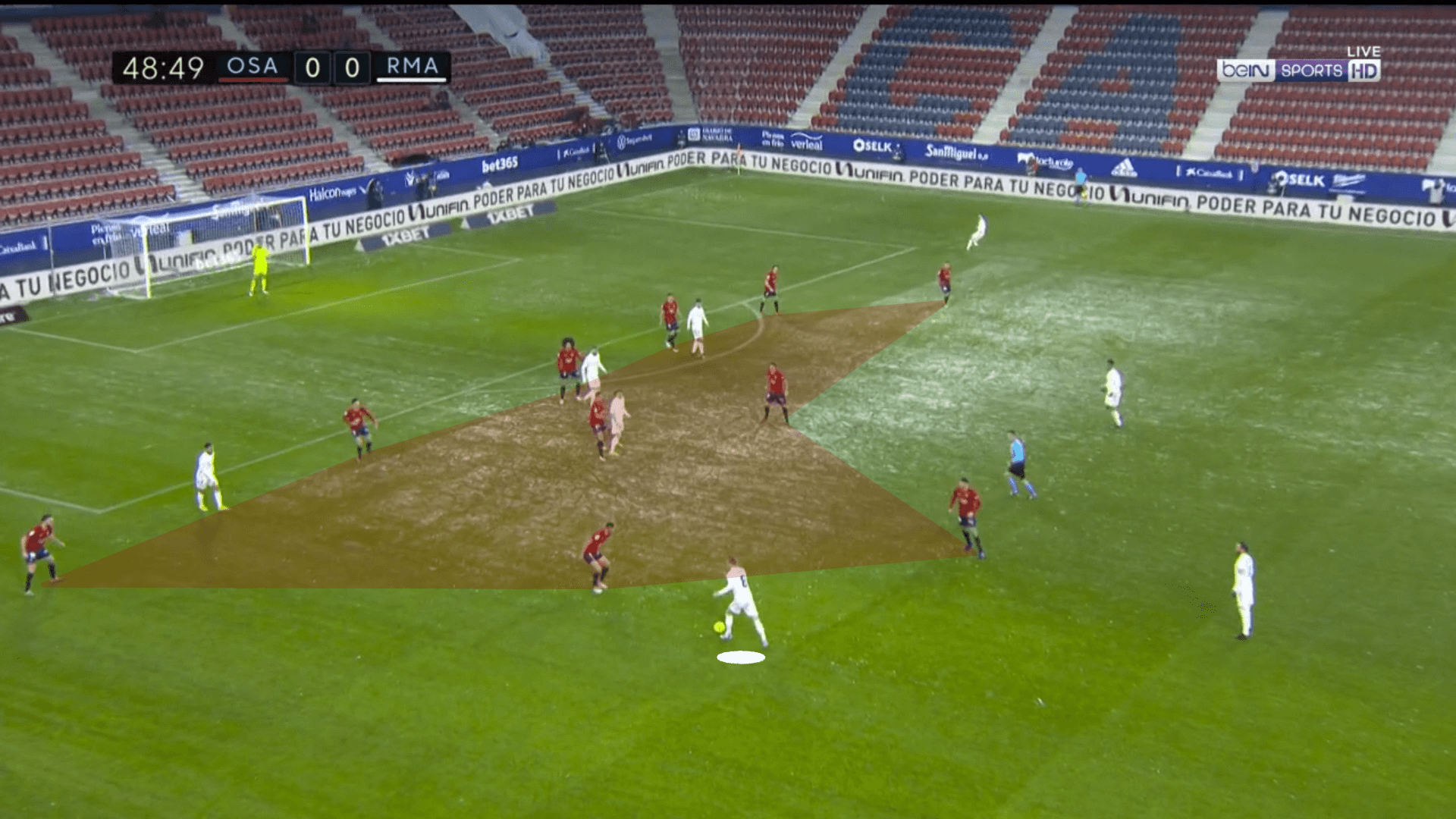
Even though Osasuna played really well against Kroos, he nearly set up the game-winner in the 89th minute with a deft chip to Benzema. Right on the money, Kroos’ delivery led to a disallowed goal. Though Kroos could have played it a moment earlier, Benzema’s offside issues were the culprit. With a clear sight of the entire backline, his timing had to be better.
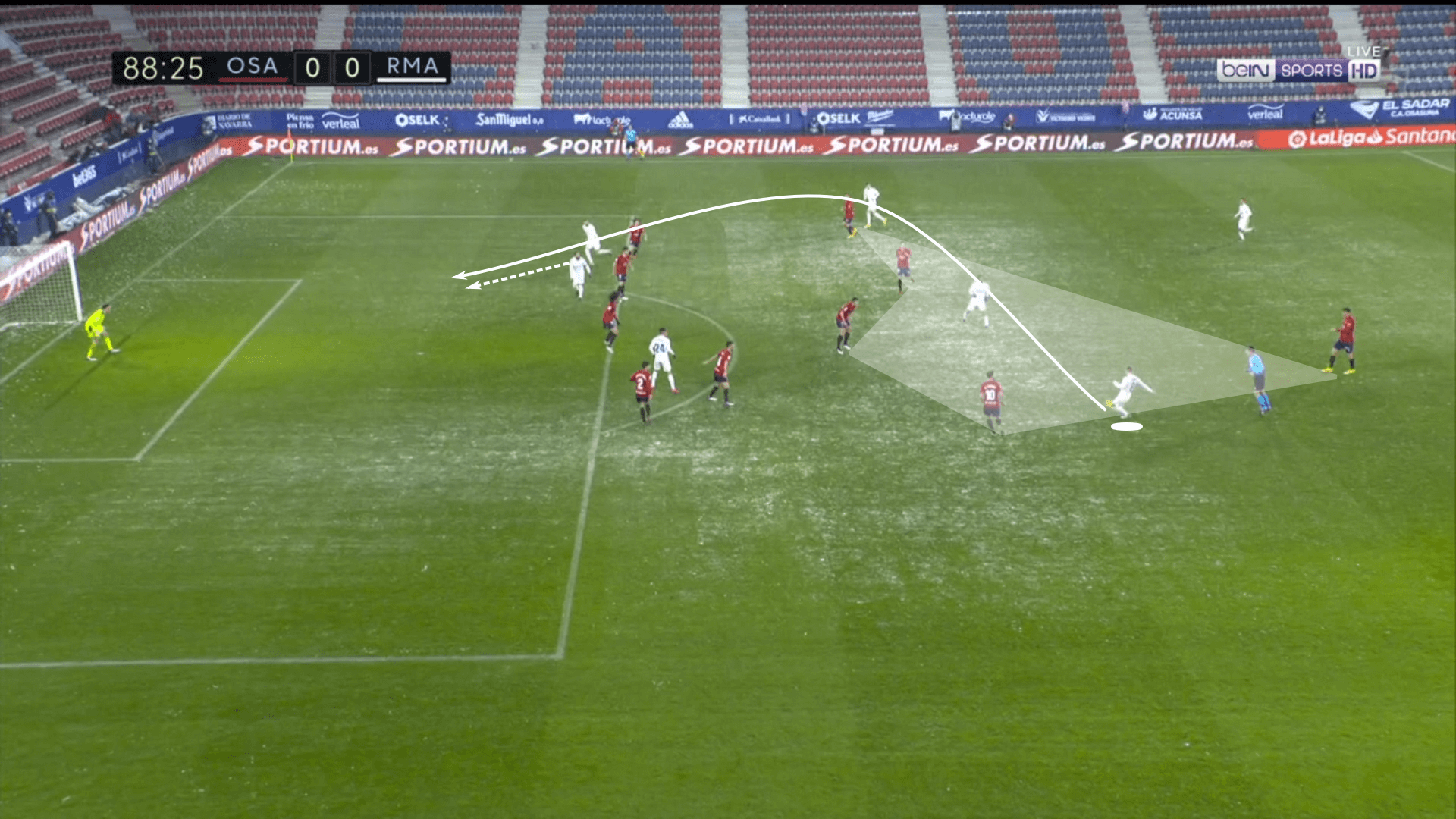
Kroos does show an ability to diversify his deliveries. In a massive win against Atletico Madrid, Kroos was again stationed outside of the opposition’s low block in the left half space. As Vinícius Júnior checked into midfield, pulling Stefan Savić with him, Benzema darted into the space behind the centre-back, a near vertical delivery that Kroos completed with ease.
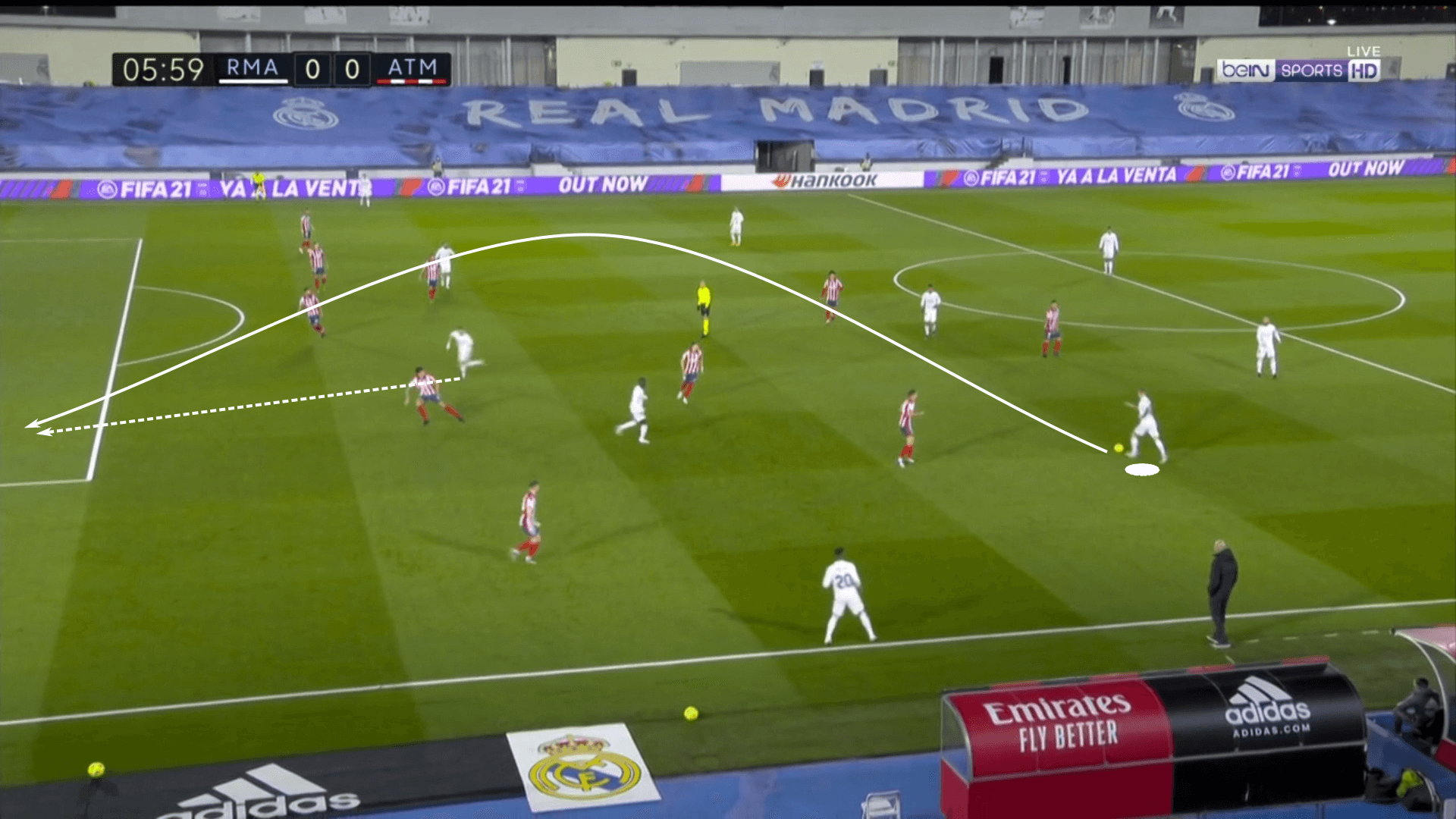
Finally, as Real Madrid enters the box, Kroos doesn’t make too many runs into the penalty area, taking a more opportunistic approach while also prioritising his place within the teams rest defence. He often finds pockets of space 25 to 30 metres from goal, so the burst into an already crowded box rarely makes sense.
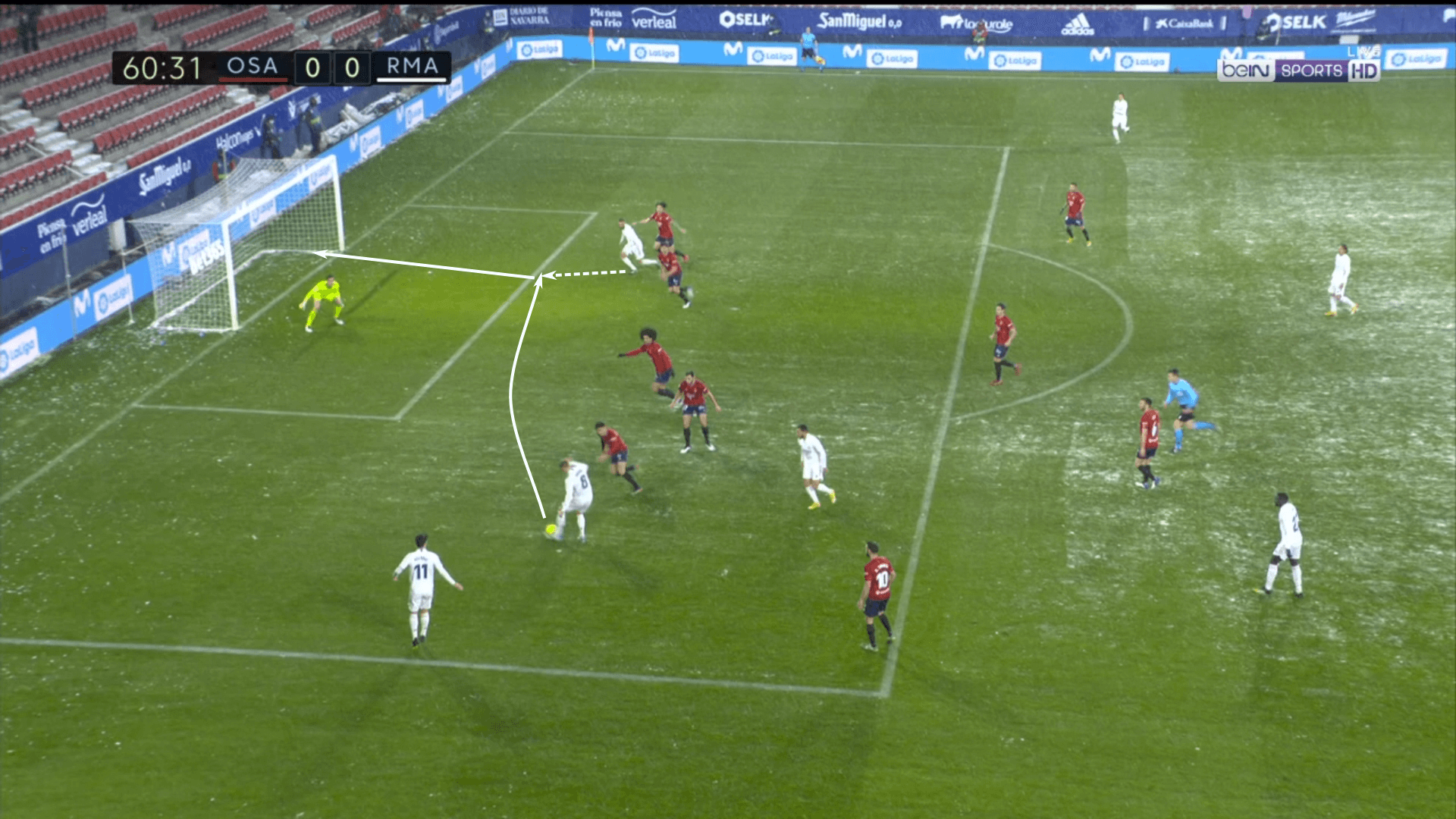
However, when he made his run into the box against Osasuna, the delivery into Benzema, who was again offside, was perfect, but it was the intelligence Kroos showcased that was most significant. He helped Real Madrid win the ball in a counterpressing scenario, then passed the ball to Eden Hazard. The moment the defence collapsed on Hazard, Kroos made a run into the box, finding just enough space to play the ball into Benzema’s path.
Role in defence
In the last sequence, we described Kroos’ contribution in a counterpressing situation, so this is the perfect time to jump into Kroos’ defensive role within the team. Even though his defensive contributions are secondary, I argue in my book that Zidane’s greatest fix in Real Madrid’s La Liga winning team was their rest defence. Toni Kroos played a major role in that tactical development. Previous years saw him positioned higher up the pitch. Between Kroos and the marauding runs of Marcelo, opponents found a lot of joy attacking Real Madrid’s left.
However, with Kroos transitioning into a regista role, his very presence prevented opponents from playing leading passes into Real Madrid’s left-wing and half space. So even though he’s not a great defender, presence alone was enough to solve the problem.
That said, when Real Madrid does counterpress, Kroos is up for the task. For example, in the match against Atlético Madrid, Kroos was situated in the central channel but recognised that Atlético’s first pass would go negative. He sprinted over and got a poke on the ball, knocking it free to one of his backtracking teammates.
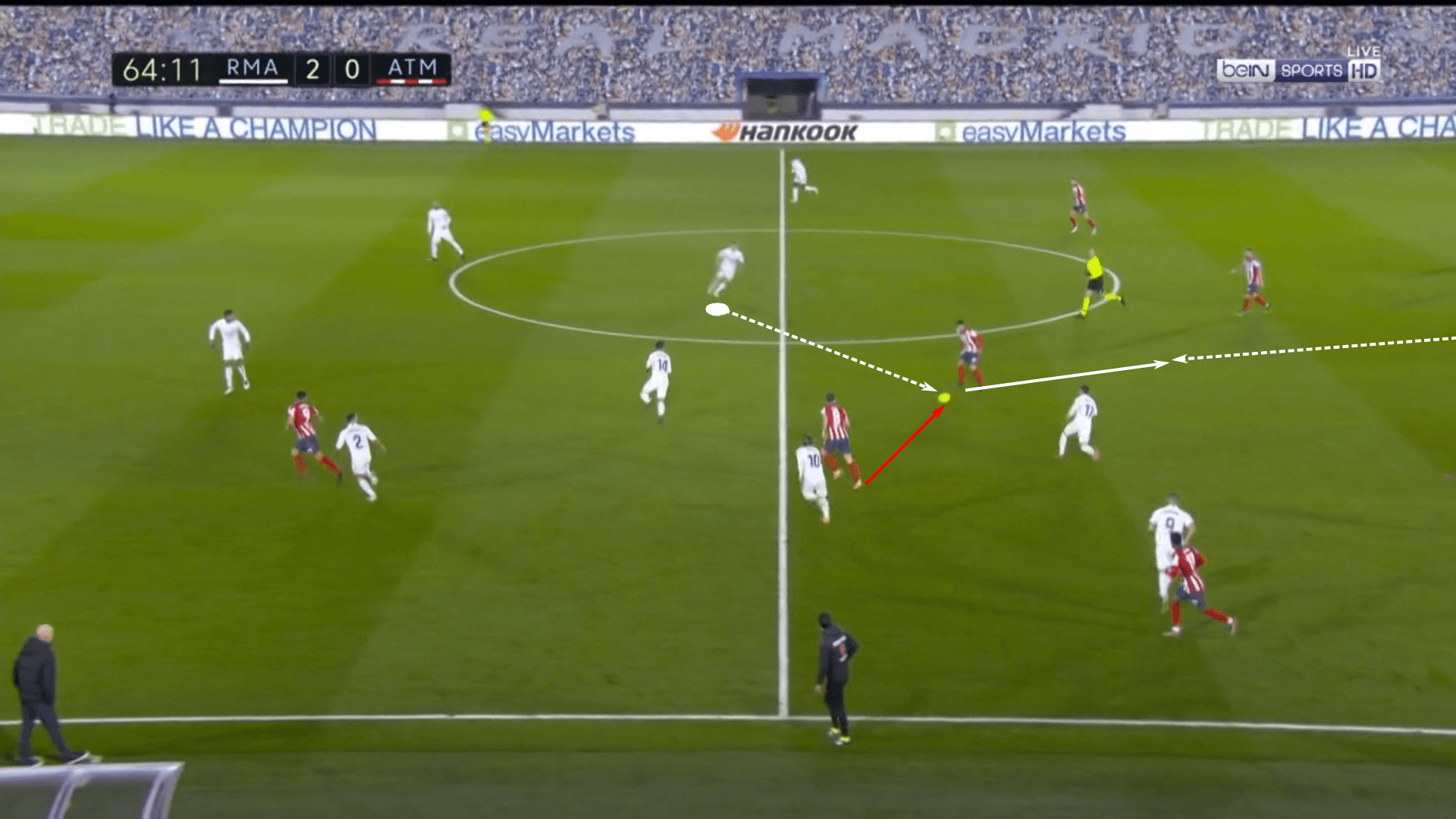
Much like the combination with Hazard that led to the disallowed goal, Kroos’ is counter pressing against Eibar, which saw him intercept the ball twice in a span of 10 seconds, saw him use his high recovery as an opportunity to slip Rodrygo behind the line. The Brazilian saw his shot saved, but, again, Kroos was the danger man in the sequence which started with his counterpressing interceptions.
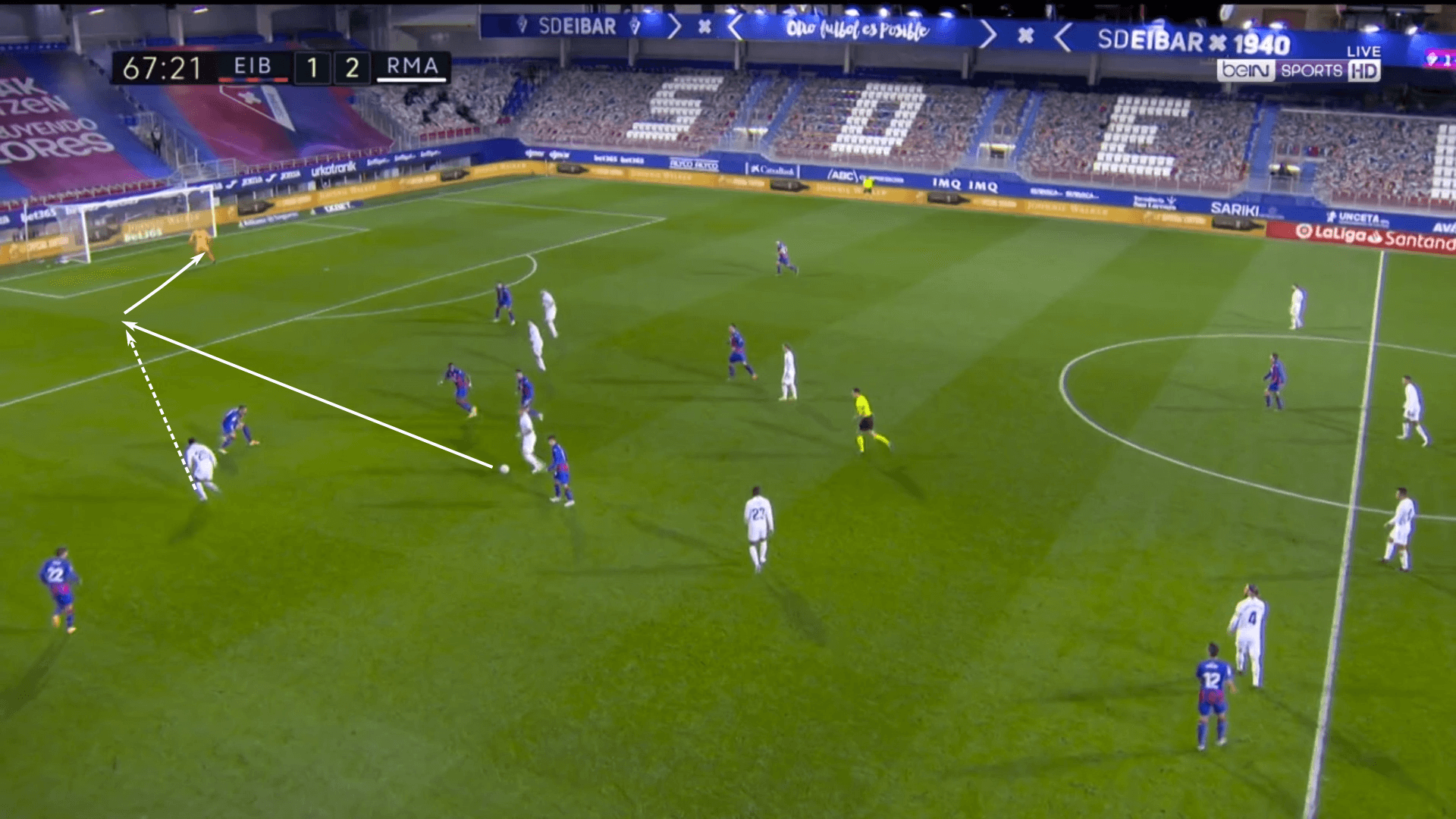
Real Madrid does enjoy a good high press, especially if they can incorporate a man-marking scheme. As Madrid engages in the man-marking high press, Kroos does have the freedom to move as high and wide as necessary. He will frequently move near the highest positioned attackers, occasionally joining Benzema in pressing the centre-backs.
As opponents push Madrid into a middle or low block, Kroos will typically recover his ground, staying closely connected with Casemiro. However, if the opportunity to press higher up the pitch presents itself, Kroos is quick to take it.
In the match against Eibar, we saw Kroos not only pressing in line with Benzema, but also high on the right-hand side of the pitch.
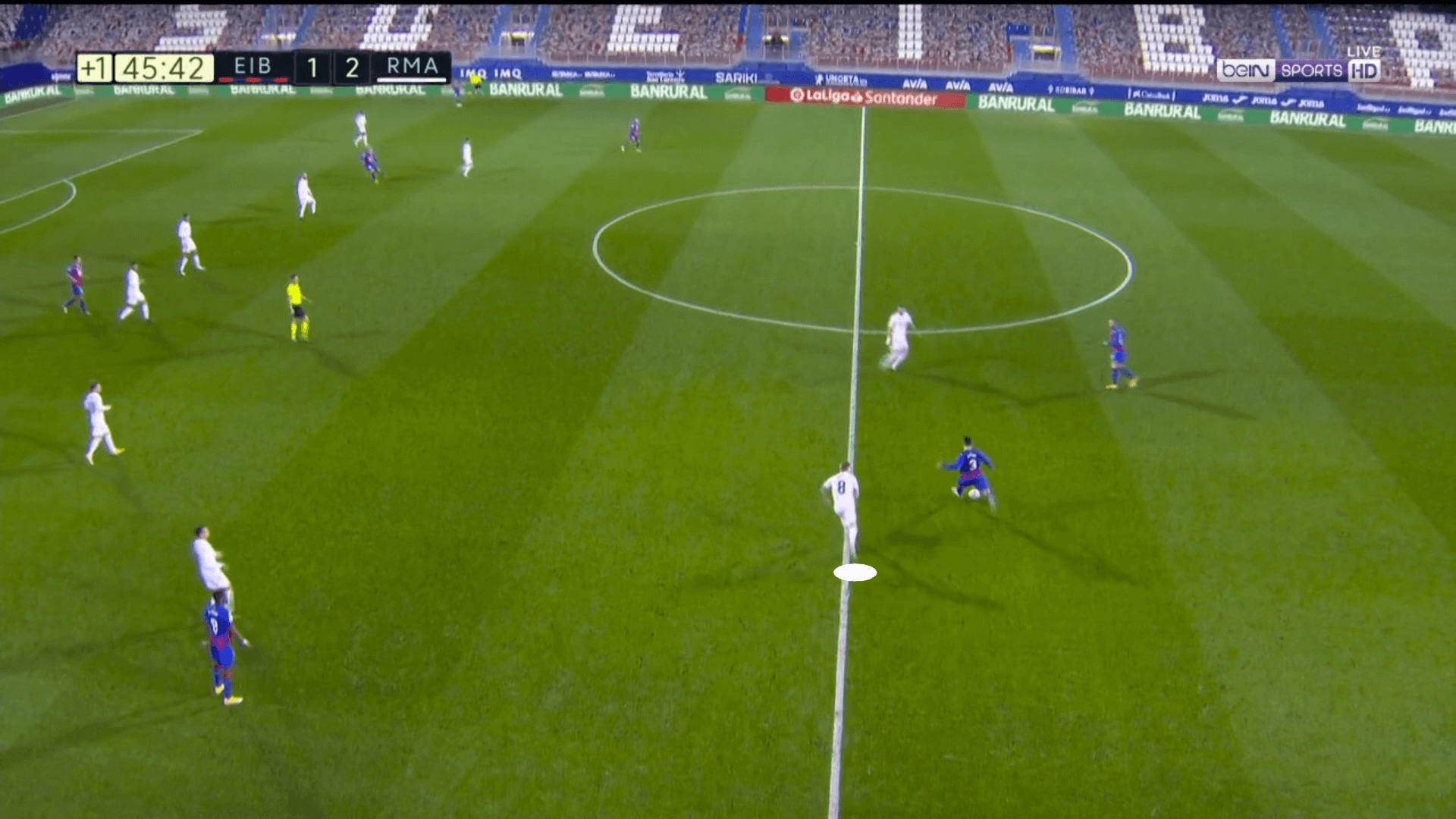
Far from his left central midfield position, Kroos has a fluid pressing role that allows him to press higher up the pitch if the opportunity presents itself. He has to ensure there is coverage behind him before leaving and that there’s an opportunity to force a turnover. If the opportunity is there, it’s his to take.
If Real Madrid has settled into a middle block, look for Kroos to at least slide into the central channel, if not into the right half space to make the field horizontally compact. If the opponents don’t carry much of a threat in the central channel, he’ll squeeze closer to the ball and eliminate one of their shorts or intermediate options, much like he did against Atlético.
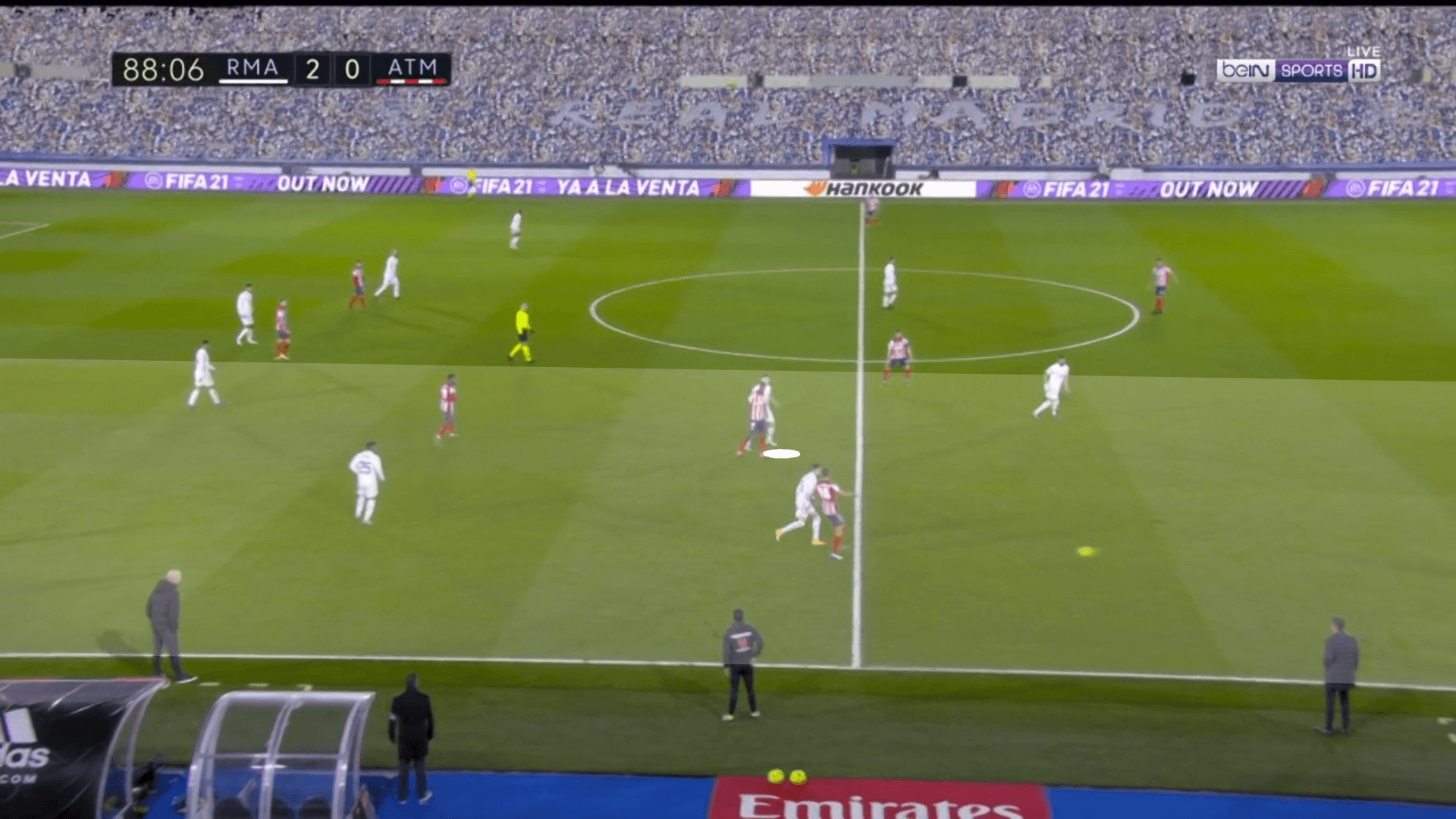
If the opponent is circulating the ball along the backline, Kroos will start in a more conservative role. However, again, if the backline is covered and Casemiro doesn’t need his help in midfield, Kroos will likely push higher up the pitch to move closer to a higher opponent or reduce the angle of play into one of the opponent’s overloads.
In the 17th minute against Atlético, Real put pressure on the ball, triggering bendy to move higher up the wing and cueing Ramos to move closer to his mark. Seeing Ramos move higher up the pitch and the pair of Mendy in Casemiro in good shape defensively, Kroos maintained a higher starting point to limit the angle into Atlético central overload.
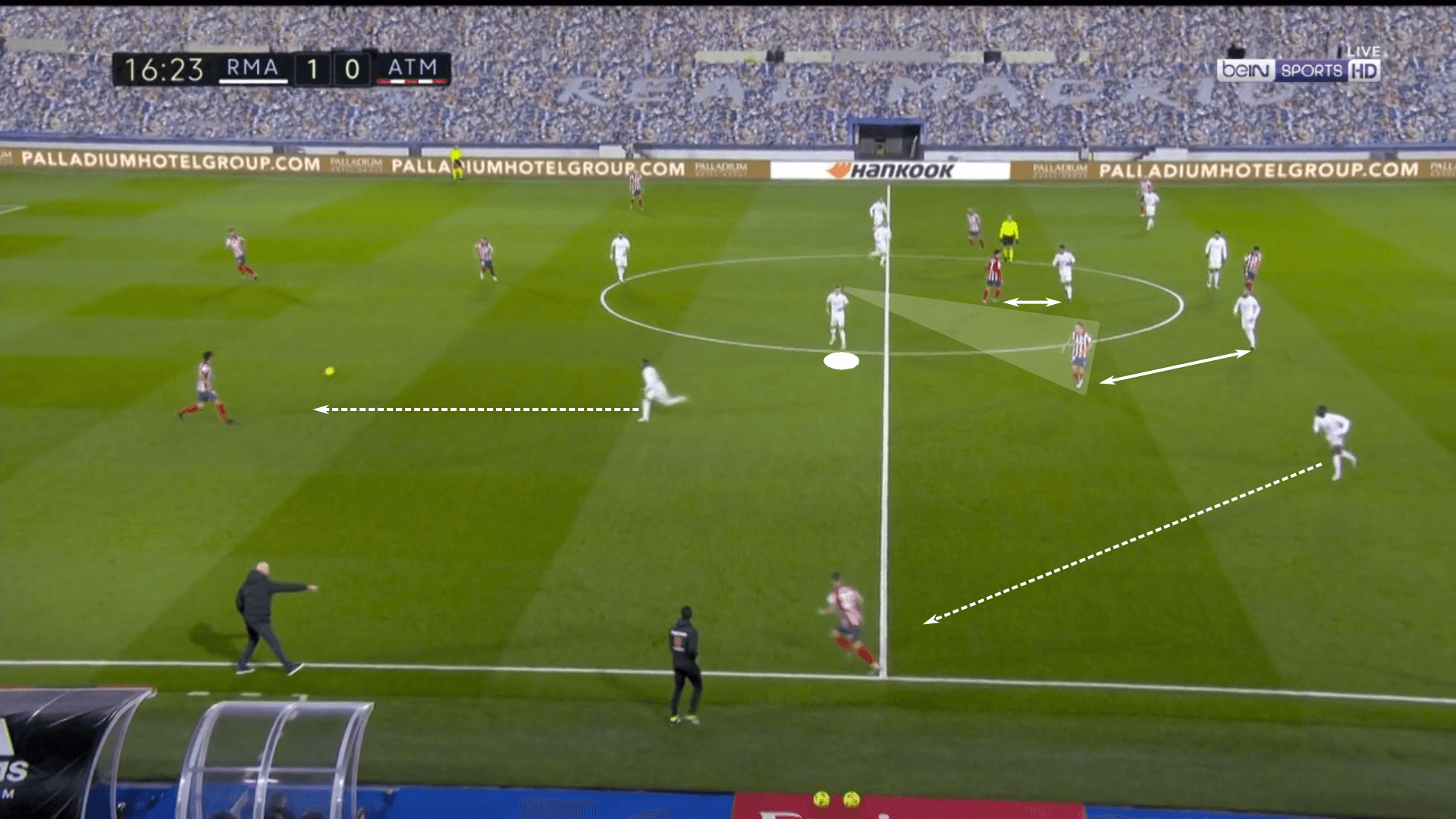
Finally, as Real Madrid retreats into a low block, you’ll often see Kroos either in the central channel or the left half space. The orientation of the ball and opponents will certainly factor into his starting point, but Kroos does make an effort to recover his ground and contribute to the team’s low block.
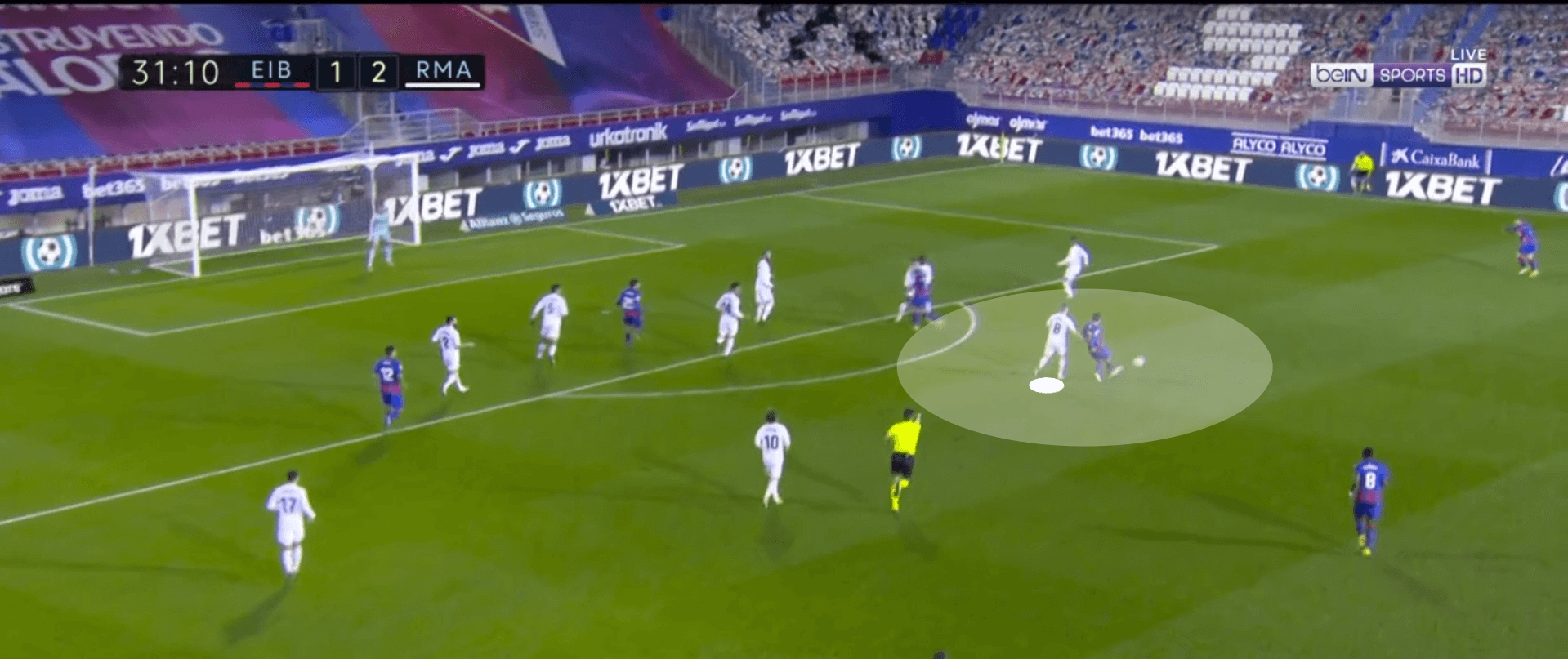
That was very much the case against Eibar. In the sequence, Eibar initially had the ball in their left-wing, which forced Kroos to move in that direction. However, as Eibar broke Madrid’s press and played out of pressure, Kroos was quick to recover his ground and offer support in the central channel.
So, sure, he’s not the greatest defender, but much like Pirlo , he benefits from a relationship with a midfield destroyer. Pirlo had Gennaro Gattuso, Kroos has Casemiro. Pairing a regista like Kroos with a ball-winning midfielder limits the scope of the regista’s defensive responsibilities. In most cases, presence is the most important factor. As long as that player is present, especially in coverage of higher positioned players, they can help the team avert danger by keeping the opponent from playing into open spaces.
Conclusion
After a phenomenal 2019/20 season, Kroos is back at it in 2020/21.
While it’s fair to say he hasn’t produced a masterclass in each match, which is evident in his statistical performances in Real Madrid’s losses and draws, especially in comparison to his statistics in wins, he’s very much running the show. It’s his ability to be a playmaker from deeper parts of the pitch, as well as his role in setting the team’s tempo, that makes him so valuable.
For Real Madrid to close the gap against their cross-town rival, Kroos must stabilise his side with consistent performances. When he is able to find his spaces outside of the opposition’s press, few in the world can match his production. After all, he is the heir to the regista throne.

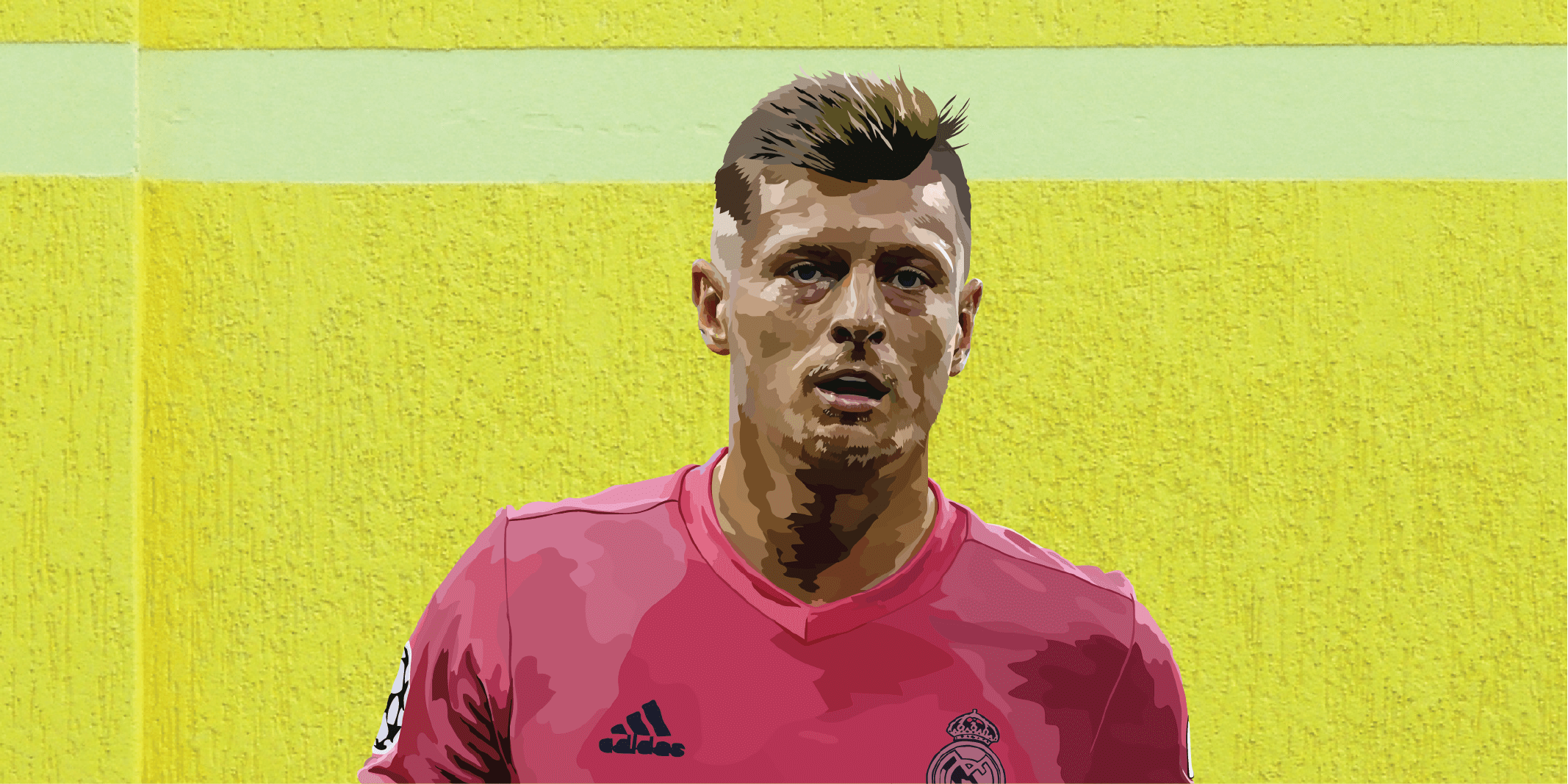



Comments